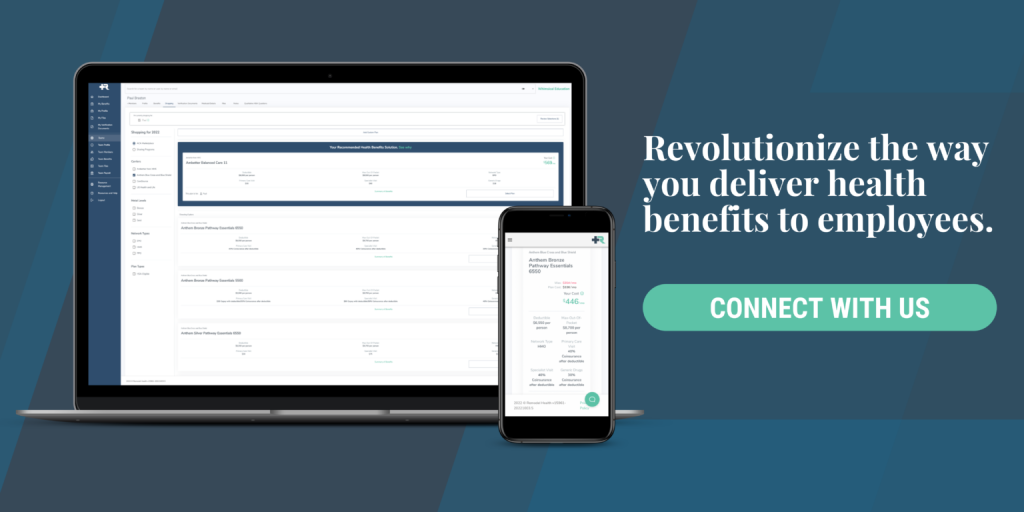
The Individual Coverage Health Reimbursement Arrangement (ICHRA) is a game changer in the world of employer-sponsored health benefits. As a business owner or HR professional, you may be considering adopting an ICHRA to provide flexibility and personalized healthcare options to your employees.
However, effectively communicating this new benefit to your team is crucial for its successful implementation.
In this blog post, we’ll delve into the best practices for communicating ICHRA to your employees and ensuring they understand its benefits.
1. Start with the Basics: What is an ICHRA?
Before diving into the specifics of your company’s ICHRA, it’s essential to provide your employees with a clear understanding of what an ICHRA is and how it works. This may be their first introduction to this type of health benefit, so avoid using technical jargon and instead focus on providing simple, straightforward information. Here’s a brief overview you can share:
- An ICHRA (Individual Coverage Health Reimbursement Arrangement) is an employer-funded account that reimburses employees for their individual health insurance premiums and qualified medical expenses.
- Unlike traditional group health insurance plans, an ICHRA allows employees to choose their own individual health insurance plan, giving them more flexibility and options to select the coverage that best fits their needs.
- ICHRAs are tax-free for both employers and employees, making them a cost-effective alternative to group health plans.
2. Explain the Benefits of ICHRA to Employees
Once your employees understand the basics of ICHRA, it’s crucial to emphasize the benefits and advantages it offers compared to traditional group health plans. Some of the key points to highlight include:
- Personalized Coverage: With an ICHRA, employees have the freedom to choose their own individual health insurance plan, allowing them to select coverage that meets their specific needs and preferences.
- Cost Savings: Since ICHRAs are tax-free, both employers and employees can save on taxes. Additionally, employees may potentially save on premiums, depending on the individual plans they choose and the reimbursement amount provided by the employer.
- Flexibility: ICHRAs can be offered alongside other health benefits, allowing employees to choose between the ICHRA and other options based on their needs.
3. Provide Clear Guidelines and Reimbursement Details
To avoid confusion and ensure a smooth transition to ICHRA, provide employees with clear guidelines and details about the reimbursement process. Be sure to cover the following points:
- Reimbursement Amounts: Clearly state the monthly reimbursement amount employees can expect, and whether there are different amounts for employees with different family sizes or ages.
- Eligible Expenses: Provide a list of eligible expenses that can be reimbursed through the ICHRA, including premiums for individual health insurance plans, copays, deductibles, and other qualified medical expenses.
- Submission Process: Detail the process for submitting reimbursement requests, including any required documentation, deadlines, and the frequency of reimbursements.

4. Offer Resources and Assistance for Plan Selection
One of the biggest challenges employees may face when transitioning to an ICHRA is selecting an individual health insurance plan. To help them navigate this process, consider providing resources and assistance, such as:
- Educational Materials: Distribute guides or host informational sessions on how to shop for individual health insurance plans and what factors to consider when selecting coverage.
- Online Tools: Share online tools and resources that can help employees compare plans, such as the Health Insurance Marketplace or private exchange websites.
- Expert Assistance: Offer access to a benefits advisor or broker who can answer employees’ questions, provide personalized guidance, and help them choose the best plan for their needs.
5. Communicate Regularly and Clearly Throughout the Process
Effective communication is the key to successfully implementing an ICHRA in your organization. Regularly updating your employees and providing clear information will help them better understand the new benefit and feel more confident in their plan selections. Some best practices for communication include:
- Begin Early: Start discussing the ICHRA transition with your employees well in advance, giving them ample time to familiarize themselves with the concept and ask questions.
- Use Multiple Channels: Utilize various communication channels to reach your employees, such as emails, newsletters, webinars, in-person meetings, and informational sessions. This ensures that everyone has access to the information they need.
- Designate a Point of Contact: Assign a specific person or team within your organization to handle ICHRA-related questions and concerns. Make sure employees know who to contact for support, and encourage open communication.
- Provide Updates: Keep employees informed about important dates and deadlines, such as when they need to choose their individual health insurance plan, submit reimbursement requests, and when reimbursements will be issued.
- Gather Feedback: Encourage employees to share their feedback and experiences with the ICHRA, so you can make improvements and address any concerns as needed.
6. Address Common Concerns and Misconceptions
It’s natural for employees to have concerns or misconceptions about ICHRAs, especially if they’re used to traditional group health plans. To help alleviate their worries, address common concerns head-on, and provide accurate information:
- Quality of Coverage: Employees may worry that individual plans offer less comprehensive coverage than group plans. Explain that individual plans are required to cover the same essential health benefits as group plans under the Affordable Care Act (ACA), ensuring they receive comparable coverage.
- Affordability: Some employees may be concerned about the cost of individual health insurance plans. Clarify that the ICHRA is designed to help offset these costs and that they can shop for plans within their budget, taking advantage of the employer’s reimbursement.
- Continuity of Care: Employees may worry about losing access to their preferred healthcare providers. Encourage them to research provider networks when selecting a plan to ensure they can continue seeing their preferred doctors.
7. Celebrate Successes and Share Employee Testimonials
As your organization transitions to an ICHRA, share success stories and positive experiences from employees who have embraced the new benefit. Hearing firsthand testimonials from their peers can help alleviate concerns and build confidence in the ICHRA. Consider sharing these stories in company newsletters, emails, or during informational sessions.
In conclusion, effectively communicating ICHRA to your employees is crucial for a successful implementation.
By providing clear, accurate information about the benefits, guidelines, and reimbursement process, offering resources and assistance for plan selection, and maintaining open communication channels, you can help your employees embrace the ICHRA as a valuable health benefit.
By following these best practices, you can ensure a smooth transition to ICHRA for your organization and empower your employees to take control of their healthcare choices.
ICHRA communication is key. We’re here to help you through this process!

Important Notice: Remodel Health does not intend to provide specific insurance, legal, or tax advice. Remodel Health always recommends consulting with your own professional representation to properly evaluate the information presented and its appropriate application to your particular situation.
